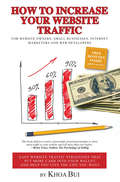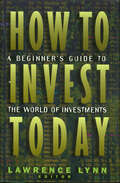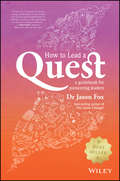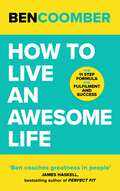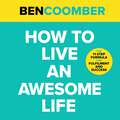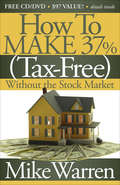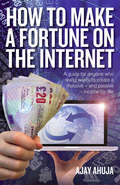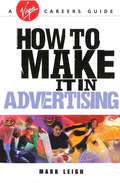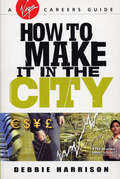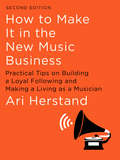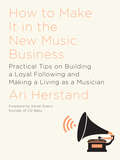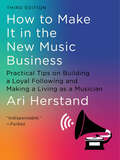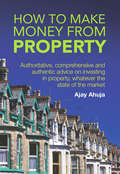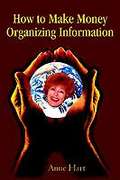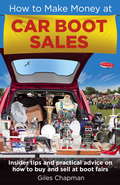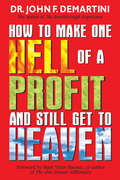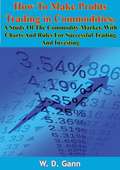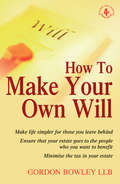- Table View
- List View
How To Increase Your Website Traffic
by Khoa BuiTHE SECRETS CONTAINED IN THIS BOOK HAVE LITERALLY MADE ME THOUSANDS OF DOLLARS ONLINE AND I HOPE IT CAN DO THE SAME FOR YOU TOO!THIS BOOK WILL HELP YOU...Climb higher in the Search EnginesAttract More Website Visitors by 500%Massively Increase Your SalesExpose Yourself to Greater Opportunities OnlineOvertake Competitor WebsitesMake More Money OnlineSell More Products and ServicesLearn How to Convert Your Traffic to SalesALSO COVERS...Social NetworkingLow Cost Traffic Generation StrategiesThe Khoa Bui Cash Website Triangle FormulaDomain Name TipsHow to Optimize Your Website for SpeedHow to Harness Publicity OnlineWhe the Colors on Your Website May Not Be EffectivePLUS ACCESS FREE AUDIO BOOK ($197 VALUE)!I'm a big fan of simplicity for success, and Khoa's new book lays out an easy-to-follow plan to increase your website traffic and convert those visitors to cash.-Ali Brown, CEO & Founder of Ali InternationalEvery single day, millions of people go online but don't visit your site. Khoa Bui wants to change that-and he can with his remarkable book. So he did his part. Now it's time for you to do yours. I predict success if you do.-Jay Conrad Levinson, Father of Guerrilla Marketing, Author of Guerrilla Marketing seriesHow to Increase Your Website Traffic is a content-rich book, packed with powerful ideas that will help Internet entrepreneurs increase their sales and business profits.-Adam Khoo, Asia's #1 Success Coach, Author of Secrets of Self-Made Millionaires
How To Invest Today: A Beginner's Guide To The World Of Investments
by Lawrence LynnAll beginner investors are rightfully skeptical: there is no end to the things awaiting good money held by good people. And all beginning investors want to find the shortest route to objective, sound advice regarding their money--advice that lays out the fundamentals and tells them what investing is all about.That advice can now be found in Lawrence Lynn's How to Invest Today. Though there are many books about the complicated art of investment, most are either filled with sophisticated jargon or narrowly focused toward a certain angle. This primer on contemporary investing, written by a team of financial professionals and writers, fills an important niche: it is a general-purpose book on today's world of money management that introduces the novice to the many facets of investment in simple, down-to-earth language:- bonds- securities- insurance- mutual funds- the stock market- annuities- real estate- options- retirement and estate planning- employee benefits- and moreIf you are not an experienced investor, this is the book for you. It explains common terms that may be unfamiliar to the newcomer--liquidity, higher current yield, growth of principle--and illustrates them with vivid hypothetical scenarios. It alerts the reader to common mistakes in investing and provides an up-to-date picture of all the basic financial options available. How to Invest Today takes the mystery out of the investments and puts the beginner at ease, with concise, uncomplicated explanations.
How To Invest in Debt: A Complete Guide to Alternative Opportunities
by Michael PellegrinoWith this nuts-and-bolts guide, both savvy and novice investors can discover the secrets to profiting from personal and corporate debt, including municipal tax liens, defaulted credit card debt, discount promissory notes, mortgage foreclosures, and micro loans. Anyone can participate in these investments, but not all of these options are as easy as calling a broker - they require some legwork and research - so many of these opportunities often go untapped.While there are many books on alternative investment ideas, none provide this level of practical information and advice. How To Invest in Debt provides everything readers need to capitalize on these investments. Readers will discover:How to find and purchase debt at a deep discountHow to do effective due diligence and pick the ones that are most likely to pay offHow to collect debt, and the secrets to making short-term high interest loansBuying future streams of cash flowOvercoming what could go wrong before it happensAnd much more. Dozens of charts, table, forms, spreadsheets, and diagrams empower readers to get started right away, with all the tools they will need to collect and analyze data and pursue the most profitable opportunities.How To Invest in Debt shows that if you're willing to do the work, you can profit from debt.
How To Lead A Quest
by Jason FoxUnlock progress through doubt and uncertainty The biggest threat facing modern business is the sheer complexity of an uncertain future. That, and the fact that everyone is busy. Too busy for progress. Workplace cultures have become cursed with efficiency. And so when it comes to developing strategy, we default to our defaults.We favour quick fixes, easy templates and familiar approaches, developing 'robust plans' that do little to mitigate strategic risk or generate new value. The result? The future comes, and businesses die. But no longer! *cue trumpets* How to Lead a Quest is a book for pioneering leaders - folks who know that enterprise strategy is far too important to condemn to 'smart goals', 'a clear vision for the future' and other such rubbish. Within this book, you'll discover how to: liberate enterprise leadership and workplace cultures from the curse of efficiency, default thinking and the delusion of progress explore complex and uncertain futures to find profound insights that mitigate strategic risks and ensure your business model remains viable create new value and enduring relevance by pioneering into unchartered and unprecedented territory embed new structures and rituals into your enterprise to build for the future, while still delivering operational excellence today. Not for the faint of heart or short-of-wit, this uniquely refreshing book bravely tackles the paradox that is pioneering leadership. You'll discover how to lead meaningful progress - even if you don't know what the goal or destination looks like.
How To Live An Awesome Life: The 11 Step Formula for Fulfilment and Success
by Ben CoomberTake a moment to consider what you want for your future. What do you want your body to look and feel like? What career do you want? What experiences do you dream of conquering?Living a life of passion, purpose and fulfilment, on your own terms, in your own way, is the key to happiness - so why are you waiting around and not taking bold action? Why hide behind upbeat selfies, making excuses instead of following your dreams? If your life isn't inspiring you, it's time to change.In 11 inspiring, actionable steps, this book will help you set BIG achievable goals that shape the life you want to live. You'll discover how to be fitter, happier and more successful, to live with vitality and zest for all that's in your life, and to ultimately live a life of fulfilment, accomplishing all your dream of, with zero regrets. Life success isn't a secret. It's a blueprint. And it's in this book. Your AWESOME future is waiting.
How To Live An Awesome Life: The 11 Step Formula for Fulfilment and Success
by Ben CoomberTake a moment to consider what you want for your future. What do you want your body to look and feel like? What career do you want? What experiences do you dream of conquering?Living a life of passion, purpose and fulfilment, on your own terms, in your own way, is the key to happiness - so why are you waiting around and not taking bold action? Why hide behind upbeat selfies, making excuses instead of following your dreams? If your life isn't inspiring you, it's time to change.In 11 inspiring, actionable steps, this book will help you set BIG achievable goals that shape the life you want to live. You'll discover how to be fitter, happier and more successful, to live with vitality and zest for all that's in your life, and to ultimately live a life of fulfilment, accomplishing all your dream of, with zero regrets. Life success isn't a secret. It's a blueprint. And it's in this book. Your AWESOME future is waiting.
How To Live An Awesome Life: The 11 Step Formula for Fulfilment and Success
by Ben CoomberIt's time to go big - this audiobook will help you visualise your life at its most awesome and show you exactly how to get there. BIG change is possible!Take a moment to consider what you want for your future. What do you want your body to look and feel like? What career do you want? What experiences do you dream of conquering?Living a life of passion, purpose and fulfilment, on your own terms, in your own way, is the key to happiness - so why are you waiting around and not taking bold action? Why hide behind upbeat selfies, making excuses instead of following your dreams? If your life isn't inspiring you, it's time to change.In 11 inspiring, actionable steps, this audiobook will help you set BIG achievable goals that shape the life you want to live. You'll discover how to be fitter, happier and more successful, to live with vitality and zest for all that's in your life, and to ultimately live a life of fulfilment, accomplishing all your dream of, with zero regrets. Life success isn't a secret. It's a blueprint. And it's in this audiobook. Your AWESOME future is waiting.(P) 2023 Hodder & Stoughton Limited
How To Make $100,000 Thanks To Youtube: Learn How You Can Get Free Targeted Traffic From Videos
by Gabriel BothIn this book “How To Make $100,000 Per Year Thanks To YouTube”, you’ll learn everything you need to start making money online with your videos and harnessing the vast potential of this platform. Nine different video marketing & YouTube experts including the author, Gabriel Both, share their expert tips, secret strategies and insider tactics that have been proven to get higher search rankings, more views, and more sales. Imagine yourself waking up in the morning, looking at your inbox and seeing that you’ve made money while you were sleeping, all thanks to YouTube. How would that make you feel? Pretty amazing, right?! Even if you’ve already tried to succeed on YouTube in the past but failed, this book will give you a renewed sense of hope along with practical advice that you can start applying today to get the results you desire.
How To Make 37% (Tax-Free) Without the Stock Market: Secrets To Real Estate Paper
by Mike WarrenEveryone knows that you can make money in the stock market, but all of the systems that teach you how to make money in the stock market require risk and a lot of work. HOW TO MAKE 37%, TAX-FREE, WITHOUT THE STOCK MARKET shows you how make at least 37% tax free on your money every year without the stock market and have it guaranteed with real estate and to get 5x the average stock market rate of return without the risk.
How To Make A Fortune On The Internet: A Guide For Anyone Who Wants To Create A Massive - And Passive - Income For Life
by Ajay AhujaIf you can point and click a mouse, type on a keyboard and have a basic grasp of the English language then you can make a fortune on the internet if you know what to do. This book will show you exactly what to do. You will learn how to: * Build a website and go live in 1 hour * Accept online payments and set up statements to track your income * Drive traffic to your site by getting your site listed instantly with the major search engines like Yahoo and Google. * Earn up to GBP10 per click every time someone clicks on your site * Earn up to GBP115 every time someone fills out a form on your site * Get other web publishers to sell your stuff *Create a database of readers you can profit from every time you update your site * Have a chat room, forum and video forum on your website for free * Automatically send out an email everyday with no input from you * Incorporate a search box on your site that makes you money every time someone searches * Add ready-made articles about your chosen subject to your site completely free - simply copy and paste!
How To Make It In Advertising
by Mark LeighAdvertising. Is it really 'the greatest art form of the twentieth century' (Marshall McLuhan)? Whatever your views, it is undeniably one of the most popular career choices going-and one of the most difficult to get into. If you want to be creative and make money, or simply fancy trying your handat a job in one of the most powerful industries around, then this indispensable guide is all you'll need to get a foot in the door and keep a step ahead of the competition. It's a careers guide with a difference, using the experience and wisdom of some of the industry's top people. You'll find essential advice on how to get started and how to get ahead, as well as the insider's view of the genuine pros and cons of each job, from copywriter to account handler. Your new career starts here.
How To Make It In IT
by Alan StewartComputers have been in daily use at work for nearly half a century. Each new generation of the technology – mainframes, mini-computers, Cs and the Internet – has brought a demand for a fresh set of skills, but there are never enough people to fill the ever-growing number of posts in the IT sector. This guarantees that there is stiff competition among employers for the best technicians, which means that salaries can be very high.The overall picture might be rosy, but if you want an honest evaluation of the different areas and jobs on offer, you need this book. Have you got the intellectual stamina to be a security analyst? What qualities and skills are employers looking for in their technical authors and operations managers? And how can you freelance successfully as a programmer or consultant? Based on interviews with people at all levels of the industry, this informed, no-nonsense guide points you to the right job – and shows you how to get it.Whether you want to be the next Bill Gates or would be quite happy in a secure job with a blue-chip company, your IT career starts here.
How To Make It In The City
by Debbie HarrisonA City career can mean a life in the fast lane, a monstrous salary and bonus package with an expense account to match. Or it could mean working in a grey suit in a grey organization with a gold watch as the only bright spot on the horizon. If you want to succeed and have fun, you need to know where to start, who's who in the profession of your choice and how to network. Good qualifications are a must in certain fields but, in the City, drive, enthusiasm and charisma are what really count. If it's a City career you're after, this guide should keep you two steps ahead of the competition.
How To Make It in the New Music Business (Second Edition): Practical Tips On Building A Loyal Following And Making A Living As A Musician
by Ari HerstandHailed as an “indispensable” guide (Forbes), How to Make It in the New Music Business returns in this extensively revised and expanded edition. When How to Make It in the New Music Business hit shelves in 2016, it instantly became the go-to resource for musicians eager to make a living in a turbulent industry. Widely adopted by music schools everywhere and considered “the best how- to book of its kind” (Music Connection), it inspired thousands to stop waiting around for that “big break.” Now trusted as the leading expert for “do it yourself” artists, Ari Herstand returns with this second edition, maintaining that a stable career can be built by taking advantage of the many tools at our fi ngertips: conquering social media, mastering the art of merchandising, embracing authentic fan connection, and simply learning how to persevere. Comprehensively updated to include the latest online trends and developments, it offers inspiring success stories across media such as Spotify and Instagram. The result is a must- have for anyone hoping to navigate the increasingly complex yet advantageous landscape that is the modern music industry.
How To Make It in the New Music Business: Practical Tips On Building A Loyal Following And Making A Living As A Musician
by Derek Sivers Ari Herstand"Ari is at the front of the front. He gets it. I've read a hundred how-to-make-it-in-the-music-biz books, and this one is today's definitive, comprehensive manual." —Jack Conte, 150+ million YouTube views, Pomplamoose, CEO of Patreon Forget everything you think you know about the odds of “making it” in the music industry. Today, odds mean nothing and success is not about lucky breaks. It’s about conquering social media, mastering the art of merchandising and simply working harder and being smarter than everyone else. We are living in the midst of an industry renaissance, one that has left the record companies desperately struggling to maintain their prominence, as a subculture of dedicated, DIY (do-it-yourself) musicians have taken over. These days talent is a given and success has to be earned. In 2008, Ari Herstand boldly turned in his green Starbucks apron to his manager, determined to make a living off his craft as a singer/songwriter. Almost a decade later, he has become a founding member of the new DIY movement and a self-sustaining musician, all without the help of a major label. Now, drawing from years of experience, Herstand has written the definitive guide for other like-minded artists, the ones who want to forge their own path and not follow the traditional markers of success, like record sales, hits on the radio or the amount of your label advance. Incredibly comprehensive and brutally honest throughout, How to Make It in the New Music Business covers every facet of the "new" business, including how to: Build a grass-roots fan base—and understand the modern fan Book a profitable tour, and tips for playing live, such as opening vs. headlining etiquette, and putting on a memorable show Become popular on YouTube, Spotify and SoundCloud Get songs placed in film and television Earn royalties you didn’t know existed and reach your crowdfunding goals Musicians will not only be introduced to all the tools available today but will be shown how to effectively leverage them to actually make money. More important, they will develop the mindset to be aware of new advancements both online and in the real world and always stay in tune with a constantly evolving landscape. There has never been a better time to be an independent musician. Today, fans can communicate with their idols by simply picking up their phones, artists are able to produce studio-worthy content from their basement and albums are funded not by "record men" but by generous, engaged supporters. As result, How to Make It in the New Music Business is a must-have guide for anyone hoping to navigate the increasingly complex yet advantageous landscape that is the modern music industry.
How To Make It in the New Music Business: Practical Tips on Building a Loyal Following and Making a Living as a Musician (Third)
by Ari HerstandNow Magazine: “Top 5 Music Business Books” Hailed as an “indispensable” guide (Forbes), How to Make It in the New Music Business returns in a significantly revised and expanded third edition. How to Make It in the New Music Business, since its first publication in 2016,?has become the go-to resource for musicians eager to make a living in a turbulent industry. Widely adopted by ambitious individuals and music schools across the world and considered “the best how-to book of its kind” (Music Connection), this essential work has inspired tens of thousands of aspiring artists to stop waiting around for that “big break” and take matters into their own hands. In this highly anticipated new edition, Ari Herstand reveals how to build a profitable career with the many tools at our fingertips in the post-COVID era and beyond, from conquering social media and mastering the digital landscape to embracing authentic fan connection and simply learning how to persevere. This edition breaks down these phenomena and more, resulting in a timeless must-have for anyone hoping to navigate the increasingly complex yet advantageous landscape that is the modern music business.
How To Make Money Dropshipping: On Autopilot Do The Work Once And Profit Forever
by Brian GravesI set this drop-shipping method up where I am bringing in decent income BUT only work 3-5 hours per week to do it, and that’s just to drive traffic. The rest is totally automated. My Method is NOT about going around trying to find the best product on Aliexpress, Ebay, Amazon etc, they work of course and I do use them, but this method is about a drop-shipper NO ONE is using to make the entire process automated. How many people's courses have you bought online that can say that? I love passive income and will show you exactly how I do it.
How To Make Money From Property: Authoritative, Comprehensive, And Authentic Advice On Investing In Property, Whatever The State Of The Market
by Ajay AhujaThere are a surprising number of ways that you can make money from property. This book will not only explain those ways but will help you decide which method is right for you based on your personal profile and attitude to risk. It will also help you to modify and fine tune your attitudes and approaches so that you can choose whether to enter the more lucrative avenues of property investment which the professionals exploit. Learn how to: - Turn your own home (whether owned or not) into a tax free, money making machine - Build a massive property portfolio just like the professionals and generate an income big enough to live on and more - Make money by refurbishing properties and getting top dollar for them - Get hotel room rates for your well located apartment in a city centre - Buy properties for GBP1 by using the appropriate legal documents - such as options (full documentation is within this book) - Make GBP000s in weeks without doing anything but shuffle a few bits of legal paperwork by flippingA" properties - Profit from the lucrative bed and breakfast market without the need for any experience - Profit from the ever growing student property lettings market and stay within current legislation - Build a profitable UK based holiday letting business
How To Make Money Organizing Information
by Anne HartHow to make money organizing information offers 29 businesses to open at home and/or online at very low cost for people who write, produce, package, research, retrieve, or organize any type of information for a variety of markets. Many of the writing and/or information related businesses or careers are especially suited to disabled people. For example, working with computer Braille or working with information for audio learning. Also helpful are careers re-packaging and organizing information for various professions and other specialty areas. Some businesses consist of using software to organize people on lists as for matching services for real estate, travel, and other services. A variety of careers for writers are discussed that will appeal to writers with disabilities as well as people who index books, for example with disabilities such as using software for the blind and editing using audio software for the visually impaired editor, writer, proofreader, or producer of learning materials and multimedia. For example, software allows blind Web designers and programmers to work with design. How to make money organizing information explains many careers--29 businesses, and writing techniques.
How To Make Money at Car Boot Sales: Insider tips and practical advice on how to buy and sell at ‘boot fairs'
by Giles ChapmanEvery weekend, throughout the year, an enormous number of British people flock to Car Boot Sales. At any one event, hundreds of them are selling off unwanted possessions or inherited junk to free up space at home and raise useful extra money. But many thousands more are searching for incredible bargains and overlooked gems. This book is a comprehensive guide to both selling and buying. It gives you all the practical information you'll need to be a success at either, as well as an insight into the mindset of both vendor and customer so you can make any 'Boot' work to your advantage. For the would-be Car Boot Sale seller or buyer, every aspect is explained by an author who's been through the process countless times.
How To Make Money at Car Boot Sales: Insider tips and practical advice on how to buy and sell at ‘boot fairs'
by Giles ChapmanEvery weekend, throughout the year, an enormous number of British people flock to Car Boot Sales. At any one event, hundreds of them are selling off unwanted possessions or inherited junk to free up space at home and raise useful extra money. But many thousands more are searching for incredible bargains and overlooked gems.This book is a comprehensive guide to both selling and buying. It gives you all the practical information you’ll need to be a success at either, as well as an insight into the mindset of both vendor and customer so you can make any ‘Boot’ work to your advantage.For the would-be Car Boot Sale seller or buyer, every aspect is explained by an author who’s been through the process countless times.
How To Make One Hell Of A Profit and Still Get In To Heaven
by John F. Demartini<P>Millions of people worldwide dream of making a "good" living, of attaining great wealth, and having an extraordinary and fortunate life. However, they haven’t yet found a way of attaining it, and they fear that they can only do so at the expense of others—perhaps by compromising their higher spiritual values and virtuous nature. <P>Some people who outwardly acknowledge their desire for great wealth feel inwardly guilty about acquiring it, and their illusive conflict blocks or dissipates their potential fortunes. Other people say they just want to be comfortable and secure rather than vastly fortunate. These individuals also hold themselves back from breaking through to new levels of financial freedom, and actually living their most cherished and inspiring dreams. In addition to their conflicting spiritual and material natures, some people have an additional internal struggle between their desires to give and receive. <P>How to Make One Hell of a Profit and Still Get to Heaven was written to help you (if you happen to be like most people) dissolve these apparent conflicts. It can assist you in making your financial dreams come true while shedding light on an entirely new way of looking at, understanding, and appreciating the true nature of Earthly profits and heavenly wealth. If you read and apply the principles and methodologies that are laid out in these pages, your relationship with, and ability to master, your spiritual wealth and material finances as well as other vital areas of your life will undergo an amazing transformation.
How To Make Profits Trading in Commodities: A Study Of The Commodity Market, With Charts And Rules For Successful Trading And Investing
by W. D. GannW. D. Gann's justly famous work on the trading of commodities."I am writing this book to supply a universal demand: and give rules that will forecast the trend of commodities. Conditions have changed rapidly during the last few years and will change more rapidly after this great war is over than ever before in history. Men will return to the soil of Mother Nature to make a living. Investors and speculators will have to look for new ways to make money in the future and will find it more difficult in the stock market; therefore, the necessities of life, the basic commodities, will offer greater opportunities than investments in stocks and bonds, providing the trader knows the rules to follow."My object is to write something that will be helpful to people in trade lines and to those who have long years of experience in the commodity market, as well as the inexperienced trader who wants knowledge and needs to learn the ways to start right, and to protect his capital and make profits. Life affords no greater pleasure than that of helping others who are trying to help themselves."I am going to give the best of my forty years of experience in this book, and I hope to show others the way to help themselves and follow mathematical rules in the commodity market, which will result in profits. I do not believe in gambling or reckless speculation, but am firmly convinced, after years of experience, that if traders will follow rules and trade on definite indications, that speculation can be made a profitable profession. Trading in commodities is not a gambling business, as some people think, but a practical, safe business when conducted on business principles."I offer this book to the public with a sincere conviction that if they put in the time studying, they will derive great benefits."
How To Make Your Own Will 4th Edition: Make Life Simpler For Those You Leave Behind - Ensure That Your Estate Goes To The People Who You Want To Benefit - Minimise The Tax In Your Estate
by Gordon BowleyThis invaluable book really will enable you to prepare your own will. It will alert you to the many and broad ranging matters you should consider, and covers factual and legal requirements and technicalities in language that the lay-person can understand. Author, Gordon Bowley, draws on his thirty years as a family solicitor to suggest the best and most effective ways of ensuring that your estate is easy to deal with by those you leave behind and that it goes to those who you want to benefit. This revised and updated 4th edition includes changes in recent legislation and case law. It includes: - Advice on choosing executors - Specimen forms, sample wills and sample clauses - A glossary clearly explaining any necessary legal terms - Guidance on inheritance tax and tax saving in your will - Information on Living Wills and Powers of Attorney
How To Make Your Own Will 4th Edition: Make life simpler for those you leave behind. Ensure that your estate goes to the people who you want to benefit. Minimise the tax in your estate.
by Gordon BowleyThis invaluable book really will enable you to prepare your own will. It will alert you to the many and broad ranging matters you should consider, and covers factual and legal requirements and technicalities in language that the lay-person can understand. Author, Gordon Bowley, draws on his thirty years as a family solicitor to suggest the best and most effective ways of ensuring that your estate is easy to deal with by those you leave behind and that it goes to those who you want to benefit. This revised and updated 4th edition includes changes in recent legislation and case law. It includes: - Advice on choosing executors - Specimen forms, sample wills and sample clauses - A glossary clearly explaining any necessary legal terms - Guidance on inheritance tax and tax saving in your will - Information on Living Wills and Powers of Attorney
